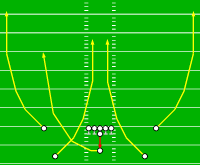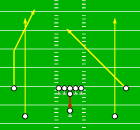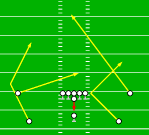Overview
Max Spread is, like Nebula, another of my more experimental pass-oriented offensive formations. Two split ends are placed as far apart as possible, which is nothing unusual. What is unusual are the two flankers placed as far in the backfield as possible while lined up almost as wide as the split ends. Max Spread passing plays tend to work at two levels, first the ends on the line of scrimmage run quick patterns, then the flankers follow in a second wave. Defenses must choose whether to send man coverage upfield to challenge the flankers or sit back in a zone and wait to see where the flankers run to.
                    
                    
                    
                    
                    
                    
|
Unlike most of my pass-oriented formations, in Max Spread the quarterback lines up under center with the halfback seven yards deep behind him. This allows for quicker passes to counter the blitz than is possible out of the shotgun, and also allows running plays up the middle as a change-up against teams expecting pass. The back also makes a good swing pass target, and is able to run wide patterns in tandem with the flanker to either side, creating defensive confusion and mismatches.
The biggest drawback of Max Spread is that jamming the split end receivers will neutralize any quick passes, as well as keep a lot of defenders close to the line of scrimmage where they can attack the flankers. Although there is no great answer to this drawback, motioning one of the flankers will bring him up to the line of scrimmage where a he may be able to get open earlier for a quick throw.
With four wide receivers assigning positions is a big decision. I place the top two receivers on the line of scrimmage to receive the quick throws crucial in the Max Spread formation. The third and fourth receivers are in the back, with #4 on the same side as #1 and #3 behind #2 for balance. The flanker routes become very important if the split ends are jammed, but are generally not the big gainers the front routes are, and as such get the lesser talent.
Plays

Antigravity
Antigravity attacks the field deep and at different levels, daring any defense to try and stop it. All four receivers run fade routes identical in form but differing in direction and starting depth. The split ends work the sidelines deep while the flankers move underneath and to the inside.

Delay Streaks
A play designed to confuse defenses. At the snap the flankers do not move, leaving the QB the option to either throw the quick SE routes or throw to the flankers in the backfield, where they can run behind a block by the SE. If nothing is open early, the flankers break into late streaks which may run past DBs who run up into close man coverage.

Zoomer
Zoomer balances out more deep strike oriented Max Spread plays with a quick hitting style. Slants and quick cross-up routes are intended to get easy 5-10 yard gains, especially against blitzes and man coverage, without forcing the QB to hold onto the ball for too long.
Contact Arkaein with any comments or questions regarding the Monstrous Madden Playbook.